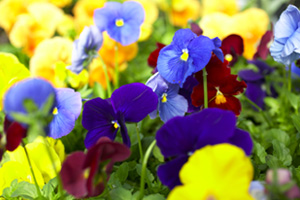NOW IS THE TIME TO MULCH YOUR PLANTING BEDS
 Very few materials distinguish an exemplary landscape from an average one like a layer of fresh mulch. When installed properly, the visual impact of having a new layer of mulch spread over the planting beds is striking in comparison to an adjacent property which has not been mulched for several years.
Very few materials distinguish an exemplary landscape from an average one like a layer of fresh mulch. When installed properly, the visual impact of having a new layer of mulch spread over the planting beds is striking in comparison to an adjacent property which has not been mulched for several years.
Attention to such details as mulching the planting bed areas is an indication of the concern the homeowner or property manager has for the landscape. Although I have spoken in earlier articles of the importance of mulch, I felt this would be a good time to remind ourselves of how the practice of mulching will benefit us and our landscapes.
There is an obvious and immediate visual benefit to your property as a fresh layer of mulch provides a distinct line of demarcation between the lawn and bed areas and improves the curb appeal of your home. There are some less obvious reasons for mulching your planting beds though. From a landscape management perspective, a layer of mulch between two and four inches thick provides a weed control measure. Most weed seeds are tiny and have a limited supply of stored food. Germinating weeds must produce their leaves quickly before this food supply is exhausted if they are to survive. When a weed seed falls on bare soil, the weed quickly establishes itself to become an eyesore as long as there is enough soil moisture and sunlight. Mulch materials do not provide a good environment for weed seedlings though. Mulches are very porous materials which dry out quickly between irrigation and/or rain cycles. Weed seeds which blow onto a layer of mulch often dry up and wither away before the weed seedling has a chance to get established in the landscape.
Mulches may be thought of as a thermal blanket to protect the root system of your landscape plants. Although the stems of trees, shrubs, and groundcovers may withstand cold temperatures common to our area, most roots will be injured when the soil temperature drops below 40 or 45 F. Also, roots can be injured or killed by excessively hot temperatures during the summer months. Any injury to the root system will be expressed in the stems, leaves, flowers and fruits of the plant. Mulch moderates temperature extremes throughout the year to help protect the plant. The highly porous nature of mulching materials forms dead air spaces within the mulch profile to insulate the soil from the high and low temperature extremes of the surrounding air, just as double and triple-pane windows provide insulation for your home.
Timely application of mulching materials is a valid horicultural practice for conservation of resources. During hot weather, much of the soil moisture needed by plants is lost through evaporation. To compensate for this loss, the irrigation rate must be increased, but that ultimately affects personal finances. Bare soils quickly heat up during the hot summer days, increasing evaporation losses. The same temperature buffering qualities which protect plant roots from temperature extremes also reduce evaporation losses from the soil and conserve soil moisture.
We have all seen the effects of heavy rains on bare soil, especially in sloped areas. A layer of mulch over the planting bed areas is an important soil conservation practice. Without a layer of protection for the soil, the outer layers of soil are carried away by wind and water movements. The loss may be gradual or it may be sudden, but the result is loss of a valuable resource … the soil itself. In time, erosion exposes plant roots to the air where they quickly dry out and die.
Most people do not think of mulch as a defense against plant diseases. However, many foliar diseases of plants occur when fungal spores on the surface of the soil are splashed onto plant leaves whenever it rains or the irrigation system is running. When water droplets strike the angular mulch particles, they disperse along the surface of the planting bed rather than deflect upward toward the plant. It has also been shown through horticultural research studies that certain types of hardwood bark mulches … the most common mulching material in our area … has a chemical composition which inhibits certain plant disease pathogens.
Since most mulching materials are organic in composition, they eventually decompose through the activity of microorganisms. This has both positive and negative aspects. The negative aspect is that the material must be periodically replaced. With the rainfall and temperatures of our area, the decomposition rate is high enough that the mulch should be replaced about once a year. The positive aspect of mulch decomposition is that the mulch breaks down to form a highly organic soil amendment. As the mulch breaks down to simpler components, these materials move downward with rainwater and irrigation to the underlying soil. As percentage of organic matter in the soil increases, so does the soil’s aeration, water-holding capacity and nutrient-holding capacity. Over time, the soil develops a more organic nature which is highly favorable to plant root growth and development. In light of the many benefits, having your planting beds mulched when needed is a worthwhile investment in the health and quality of your landscape.

Written By: Dr. Mark Nash Ph.D
Horticulturalist
Rich-Way Landscape